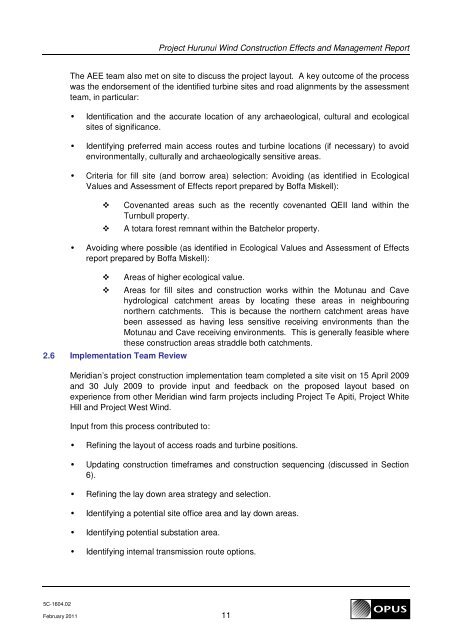Project Hurunui Wind Construction and Project Overview
Project Hurunui Wind Construction and Project Overview
Project Hurunui Wind Construction and Project Overview
Create successful ePaper yourself
Turn your PDF publications into a flip-book with our unique Google optimized e-Paper software.
<strong>Project</strong> <strong>Hurunui</strong> <strong>Wind</strong> <strong>Construction</strong> Effects <strong>and</strong> Management Report<br />
The AEE team also met on site to discuss the project layout. A key outcome of the process<br />
was the endorsement of the identified turbine sites <strong>and</strong> road alignments by the assessment<br />
team, in particular:<br />
• Identification <strong>and</strong> the accurate location of any archaeological, cultural <strong>and</strong> ecological<br />
sites of significance.<br />
• Identifying preferred main access routes <strong>and</strong> turbine locations (if necessary) to avoid<br />
environmentally, culturally <strong>and</strong> archaeologically sensitive areas.<br />
• Criteria for fill site (<strong>and</strong> borrow area) selection: Avoiding (as identified in Ecological<br />
Values <strong>and</strong> Assessment of Effects report prepared by Boffa Miskell):<br />
<br />
<br />
Covenanted areas such as the recently covenanted QEII l<strong>and</strong> within the<br />
Turnbull property.<br />
A totara forest remnant within the Batchelor property.<br />
• Avoiding where possible (as identified in Ecological Values <strong>and</strong> Assessment of Effects<br />
report prepared by Boffa Miskell):<br />
<br />
<br />
Areas of higher ecological value.<br />
2.6 Implementation Team Review<br />
Areas for fill sites <strong>and</strong> construction works within the Motunau <strong>and</strong> Cave<br />
hydrological catchment areas by locating these areas in neighbouring<br />
northern catchments. This is because the northern catchment areas have<br />
been assessed as having less sensitive receiving environments than the<br />
Motunau <strong>and</strong> Cave receiving environments. This is generally feasible where<br />
these construction areas straddle both catchments.<br />
Meridian’s project construction implementation team completed a site visit on 15 April 2009<br />
<strong>and</strong> 30 July 2009 to provide input <strong>and</strong> feedback on the proposed layout based on<br />
experience from other Meridian wind farm projects including <strong>Project</strong> Te Apiti, <strong>Project</strong> White<br />
Hill <strong>and</strong> <strong>Project</strong> West <strong>Wind</strong>.<br />
Input from this process contributed to:<br />
• Refining the layout of access roads <strong>and</strong> turbine positions.<br />
• Updating construction timeframes <strong>and</strong> construction sequencing (discussed in Section<br />
6).<br />
• Refining the lay down area strategy <strong>and</strong> selection.<br />
• Identifying a potential site office area <strong>and</strong> lay down areas.<br />
• Identifying potential substation area.<br />
• Identifying internal transmission route options.<br />
5C-1604.02<br />
February 2011 11
















